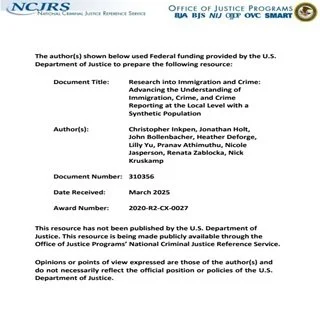By Christopher Inkpen, Jonathan Holt, John Bollenbacher, Heather Deforge, Lilly Yu, Pranav Athimuthu, Nicole Jasperson, Renata Zablocka, Nick Kruskamp
This report, funded by the National Institute of Justice (award #: 2020-R2-CX-0027) and prepared by RTI International, describes the results of a National Institute of Justice-funded research study that uses advanced analytical methods and novel datasets to explore the complex relationship between immigration, crime, and crime reporting at the neighborhood level. The study, which employs crime and crime reporting data from ten jurisdictions across the United States paired with a synthetic population that estimates the unauthorized immigrant population, aims to provide an in-depth analysis at the Census tract level. Analyses focus on unauthorized immigration and its correlation with drug, property, and violent crime rates, while accounting for crime reporting in traditional and emerging immigrant destinations along with sites with low foreign populations. BackgroundL Despite persistent political discourse linking immigration and increases in crime, most academic research contradicts this notion, showing either a negative or null relationship between immigration and crime. At the individual level, first-generation immigrants tend to have lower arrest rates than native-born citizens. Yet this trend diminishes with subsequent generations, as the children of first-generation immigrants (i.e., second generation immigrants) are often arrested at similar rates to children of native-born citizens. However, few studies assess the relationship between documentation status and offending. Macro-level analyses that focus on crime and immigration in specific areas reveal that areas with higher immigrant populations often experience lower crime rates or that the prevalence of immigrants in an area is not associated with an increase in arrests. Yet these studies frequently omit distinctions in documentation status, as these data are often unavailable. Further, many macro-level analyses are conducted at the county, state, or city level, which may obscure relationships observed at local levels. This study also attempts to control for the nuances of crime reporting among immigrant populations. Immigrant neighborhoods, especially those in emerging destinations, show lower rates of crime reporting. Trust in the police and fear of deportation are potentially significant factors influencing the likelihood of underreporting crimes. highlighting the importance of community-police relations. Strong police-community relations are crucial for public safety as they foster trust and cooperation, leading to more accurate crime reporting, effective law enforcement, and safer spaces. Methodology and Data Sources This study uses a variety of data sources to analyze the relationship between the presence of unauthorized immigrants in a Census tract and corresponding crime rates. Synthetic Population Development Traditional methods for estimating the unauthorized immigrant population in the United States rely on either demographic accounting or model-based survey imputation techniques. Defined simply, demographic accounting involves subtracting the estimated number of legally present immigrants from the total foreign-born population recorded in U.S. Census Bureau surveys. These techniques may also employ logical edits to large survey datasets that use characteristics like age, education, and place of birth to infer unauthorized status. Model-based survey imputation techniques combine data from different survey datasets to estimate unauthorized status in nationally representative surveys, using statistical techniques to merge information from surveys with immigration queries and those with extensive geographic detail. This study builds on the work of model-based imputation methods by developing models that predict unauthorized status in a survey dataset and applying them to a synthetic population of the United States, based on U.S. Census Bureau survey datasets. This approach allows for granular estimates of unauthorized immigrant populations at the Census tract level. By combining data from the Survey of Income and Program Participation (SIPP) and the American Community Survey (ACS), the study developed a robust model to predict unauthorized status and produced Census tract-level estimates of the unauthorized immigrant population for 2019. Validation efforts for these estimates included comparisons with county- and state-level estimates from sources like the Migration Policy Institute and Pew Research Center along with scaling local estimates to meet state-level figures
Research Triangle Park, NC: RTI International, 2024. 53p.


